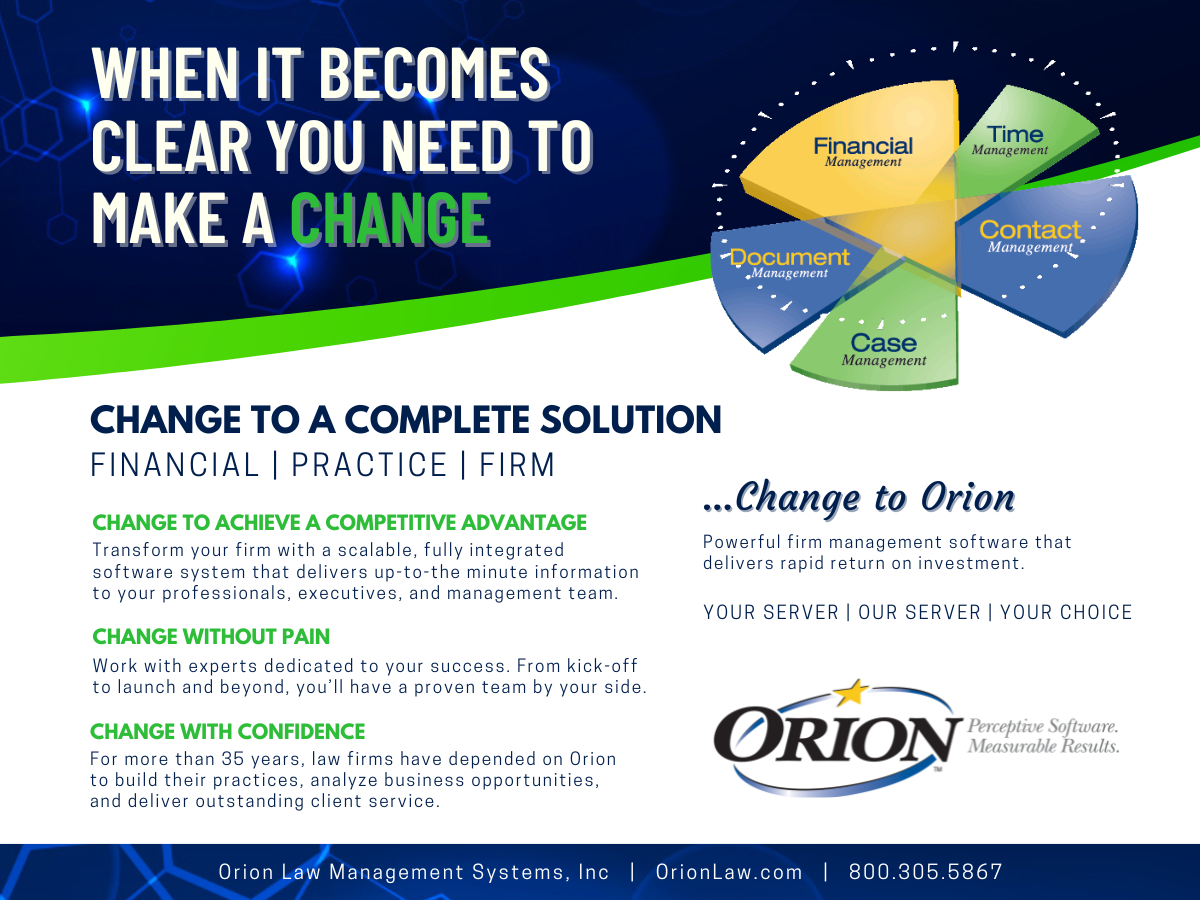“We were working with local counsel we really liked [and] trusted, and eventually just fthought it makes a lot more sense for us to be on the ground in Mexico,” says Chairman and Managing Partner John Polson. “We’ve had a lot of interest [in] some cross-border work. Over half of our largest manufacturing clients have facilities in Mexico, and we’re hoping to work with a lot more of them now.”
In the decades since its 1943 founding, Fisher Phillips has also expanded the services it provides to include resources such as an artificial intelligence (AI)-focused team that two firm members launched a couple of years ago.
“Not all of our clients have an immediate need for help,” Polson says. “But at least one watched my team speak about AI and said, ‘I’m so impressed about how robust your team is that we’d like to switch all of our [labor and employment] legal services to you.’ It's remarkable how it gives people a vision into what we can do for them, in terms of being forward-thinking.”
Adding a new practice area or location may position a law firm to better serve existing clients — and help attract new ones. Pursuing those rewards, however, can involve sizable expenses and other risks.
If you’re considering offering new operational elements, take the following factors into account to ensure you are successful.
ADJACENT SERVICE AREAS
Pacific Cascade Legal, which initially was based in Portland, Oregon, and focused solely on family law cases, has since established other offices throughout the state and Washington — and incorporated estate planning capabilities in 2016, bankruptcy representation in 2021 and personal injury services in 2022.
“Personal injury and bankruptcy can both dovetail into family law,” Founding Partner Lewis Landerholm says. “Estate planning started organically because we had family law clients with the need. Our ultimate goal was to create a dynamic where clients could come to one place for many of their legal needs, rather than having to get involved with multiple firms.”
Referrals can sometimes indicate new types of work that may be profitable for a firm.
US Legal Groups, the parent company of a trio of divorce and family law firms in New Mexico, Nebraska and Colorado, hired an estate planning attorney after noticing a considerable amount of business was being handed off to other providers, says Brent Harkins, the company’s Chief Marketing Officer (CMO) — who also serves as CMO for Cardinal Concepts, the law firm consulting service he co-founded with US Legal Groups’ Chief Executive Officer.
“The riches are in the niches,” Harkins says. “At a certain point, if your growth plan is successful, you will reach market saturation. To continue to grow and scale at an effective rate, looking at new practice areas that complement your existing services is a super easy way to acquire clients at a much lower cost per acquisition.”
INTERNAL AND EXTERNAL RESOURCES
Bringing a new attorney or practice group in with specific legal experience can help a firm quickly offer new services, but it may not automatically equate to significant business growth.
Securities law firm Sichenzia Ross Ference Carmel LLP brought a team on board years ago it hoped would help build an urban commercial real estate practice. The group’s work, however, ultimately focused more on residential closings in the suburbs, according to SRFC Founding Member and Partner Gregory Sichenzia.
“Even though we do, because of our core business, have a lot of opportunities to refer commercial real estate [work], that [didn’t happen],” Sichenzia says. “So that lasted a couple of years and faded away.”
“Adding a new practice area or location may position a law firm to better serve existing clients — and help attract new ones. Pursuing those rewards, however, can involve sizable expenses and other risks.”
Creating subsets within existing practice groups — such as the blockchain and crypto specialty attorneys within SRFC’s corporate finance group originated several years ago — may require less of an upfront investment.
That type of structure, Sichenzia says, can work well for emerging and in-demand business areas that may turn out to be more of a trend than a long-term legal need.
“A lot of what you see is existing practice groups developing new expertise they can try to market,” he says. “[You] attend some seminars, do a few deals, call yourself an expert and put it on the website.”
Partnering with providers in other locations can be a potential way to cost-effectively expand geographically. SRFC, for instance, refers business to a group of lawyers in Israel it’s affiliated with, and they suggest the firm for U.S.-based work.
“People do look at us more as an international firm,” Sichenzia says. “A lot has changed since COVID. Real estate, in general, people don’t want; it’s just a cost you don’t need.”
DATA ANALYSIS
Market research can help you determine whether a certain city or state might be a good place to open an office, according to Harkins.
“If you are a higher-end legal service provider, cost is a key consideration,” he says. “[That can involve] looking into things like what is the household income of an area? How many active attorneys are currently servicing that population base? In addition to that, you can look at public court filings to get a sense of how many cases are being tried in that area.”
To estimate how many attorneys a given office can support, Harkins works backward from the number of new matters an attorney needs to add per month to maintain a full-scale roster of active cases.
“We know 50% of paid consultations convert into clients,” he says. “About 20% of our total leads turn into booked paid consults. If the average cost per lead is $70, and we need to generate 40 per attorney, that gives us a baseline number, from a budgeting and spend perspective. We can also look at the total search volume to figure out how much of the piece of the pie are we getting. That gives us visibility into what we believe we can scale to.”
MULTIPLE MARKETING APPROACHES
When entering a new community, a family and divorce lawyer could potentially expand their reach by building a relationship with a local therapist or counselor and generating a two-way referral stream, Harkins says.
While US Legal Groups has employed conventional advertising methods like bus displays, the firm has found paid search advertising can be the fastest way to connect with clients as an unrecognized brand in a new market, Harkins says.
“You can work on your search engine optimization efforts by having a keyword strategy that focuses on that market,” he says. “You use a geo-modifier keyword such as Fort Collins, and [a term involving] your service; Fort Collins divorce attorney, for example — creating web content that is focused on that. That has a longer runway to getting you ranked and in front of potential prospects.”
OPERATIONAL IMPACT
New practice groups and locations can introduce additional tasks. Pacific Cascade Legal carved out time to go over the associated workload requirements as it moved toward entering new practice areas.
“We made sure to schedule as many meetings as was needed in those early days so our bankruptcy and personal injury attorneys could work with our staff to ensure everyone felt prepared, supported and trained,” Landerholm says. “This was especially important for our intake team, so that they felt confident in what types of questions to ask new callers and how to field potential clients.”
US Legal Groups’ attorneys share client needs, deliverables and other information with leadership, which is typically conveyed to staff during a half-day training session, Harkins says.
“When entering a new community, a family and divorce lawyer could potentially expand his reach by building a relationship with a local therapist or counselor and generating a two-way referral stream.”
Even with attentive preparation, though, firms may still need to tweak processes.
“We do our best to set up a best-in-class user experience, both for our internal and external team,” Harkins says. “We usually do a lunch and learn, and then do some demo trainings. From there, you have to be adaptive and make changes as you gather feedback.”
THE CAPACITY FOR EXPANSION
Adding new services or markets can help law firms boost revenue; yet the benefits, Sichenzia says, can extend far beyond that.
“It also increases your profile and ability to become a full-service law firm, and not just a boutique firm with a couple of specialties,” he says. “The more well-rounded you can become, you have a better chance of retaining larger clients as their needs increase.”
However, when opening an office or instituting a new practice group, timing can be everything.
Harkins recommends only embarking on a new business opportunity, no matter how enticing it may seem, if you’re absolutely certain the additional service will complement — and not compete with — your current offerings.
“You can’t diminish the expertise you provide just to chase a shiny new object,” he says. “Having a pragmatic point of view is important before opening up a new practice vertical or office location. Both items will require capital investments — you want to make sure you’re not putting your core business at risk.”


